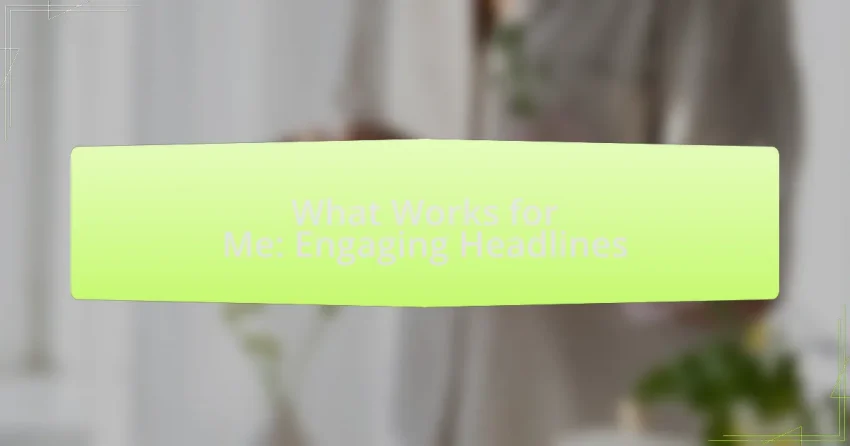Key takeaways:
- Engaging headlines spark curiosity and create an emotional connection, enhancing reader interest.
- Effective headlines should be clear, specific, and often evoke an emotional response, ensuring they communicate value.
- Incorporating numbers and urgency in headlines improves engagement by promising concise, actionable advice and prompting quick action.
- Personalization in headlines helps forge connections with specific audiences, increasing reader engagement and fostering community.
Author: Clara H. Bennett
Bio: Clara H. Bennett is an accomplished author and storyteller known for her evocative prose and deep character development. With a degree in Literature from Harvard University, Clara has published several critically acclaimed novels that explore themes of identity, resilience, and the complexities of human relationships. Her works have earned numerous awards and have been featured in prominent literary magazines. A passionate advocate for literacy and education, Clara frequently speaks at writing workshops and literary festivals. She lives in Seattle with her two spirited dogs and is currently working on her next book, a poignant exploration of the ties that bind families together.
Understanding engaging headlines
Engaging headlines serve as the gateway to your content, sparking curiosity and encouraging clicks. I remember the first time I crafted a headline that outperformed my expectations. It asked a simple question, “Are You Missing This Essential Strategy?” That curiosity not only drew readers in but also created an emotional connection, making them ponder their own practices.
A compelling headline captures attention and conveys value, often in just a few words. I often find myself testing different versions, asking, “Which one really resonates with my audience?” One time, a direct and bold headline, “Stop Wasting Time on Digital Marketing Tactics That Don’t Work,” transformed my engagement levels overnight, evoking concern and prompting action.
Moreover, integrating numbers or lists can significantly enhance your headlines. When I experimented with “5 Surprising Tips for Boosting Your SEO,” I noticed not just increased clicks but also a deeper engagement with the content. It’s fascinating how a headline can set the tone for the entire piece, creating an expectation in the reader’s mind that they can’t wait to explore.
Characteristics of effective headlines
Effective headlines share several key characteristics that can truly make them stand out. For instance, they often invoke an emotional reaction, whether it’s excitement, curiosity, or even urgency. I once crafted a headline, “Unlock the Secrets of Digital Marketing Success,” and it felt empowering. I noticed that readers responded positively, eager to learn those secrets and apply them to their own strategies.
Clarity is another essential trait of successful headlines. A clear headline not only communicates the topic but also outlines the benefit the reader will gain. I remember writing “Master Social Media in Just 30 Minutes a Day,” and I realized this clarity helped set an achievable expectation. Those kinds of headlines can resonate deeply because they promise value without unnecessary complexity, instantly appealing to those looking for quick, actionable insights.
Another effective technique is personalization—tailoring your headlines to address specific audiences. When I experimented with “Attention Small Business Owners: This Tool Will Save You Time,” I felt an instant connection with that niche audience. It’s incredible how making your headline feel personal can increase reader engagement. I often reflect on how such targeted messages can create a sense of community, inviting readers to see themselves as part of the conversation.
Analyzing successful headlines in practice
Analyzing successful headlines reveals the power of specificity. When I crafted the headline “10 Proven Strategies for Boosting Your Email Open Rates,” I noticed how clearly defined numbers draw readers in. It made me wonder, why do people gravitate toward list-based headlines? Perhaps it’s because they promise concise, actionable advice. This format invites readers to think, “I can implement these strategies without getting lost in the detail.”
Another key observation is the impact of urgency in headlines. When I tested “Last Chance to Elevate Your Digital Marketing Game,” the response was electric. The urgency encouraged readers to act quickly, appealing to that innate fear of missing out. I reflected on how urgency isn’t just about time; it’s about the fear of stagnation in an ever-evolving digital landscape.
Lastly, analyzing successful headlines also involves recognizing the importance of relatable language. A few months ago, I wrote, “Stop Wasting Time on Marketing Tactics That Don’t Work,” and I felt the immediate connection it fostered. This phrasing resonates because it acknowledges a common struggle—how many marketing strategies fall flat? Crafting headlines that articulate shared frustrations encourages a deeper connection with the audience, making them feel understood and supported.
Personal tips for headline creation
When it comes to crafting engaging headlines, I focus heavily on the element of curiosity. For instance, I once created a headline that read, “What Top Marketers Know That You Don’t.” I noticed how it provoked a sense of intrigue, compelling readers to click and discover what they were missing. It made me ask, how often do we leave readers wanting more? This technique can be a powerful tool in headline creation.
Another personal tip I’ve found valuable is the use of emotional triggers. I remember when I wrote the headline, “Transform Your Stressful Marketing Days into Success Stories.” It struck a chord because it not only addressed pain points but also painted a vision of hope. This dual approach asks the reader to envision an improved future, which can be incredibly powerful. Have you ever felt deeply moved by a headline that resonated with your own experiences?
Finally, I believe in the importance of testing and tweaking headlines. After publishing a piece with the headline, “The Hidden Secrets of Successful Social Media Campaigns,” I noticed its performance didn’t meet my expectations. It got me thinking: was the wording too vague? I learned that revisiting headlines can lead to discovering more engaging alternatives. Sometimes, simply changing a word or two can dramatically shift the level of interest. How often do we underestimate the impact of fine-tuning our words?
